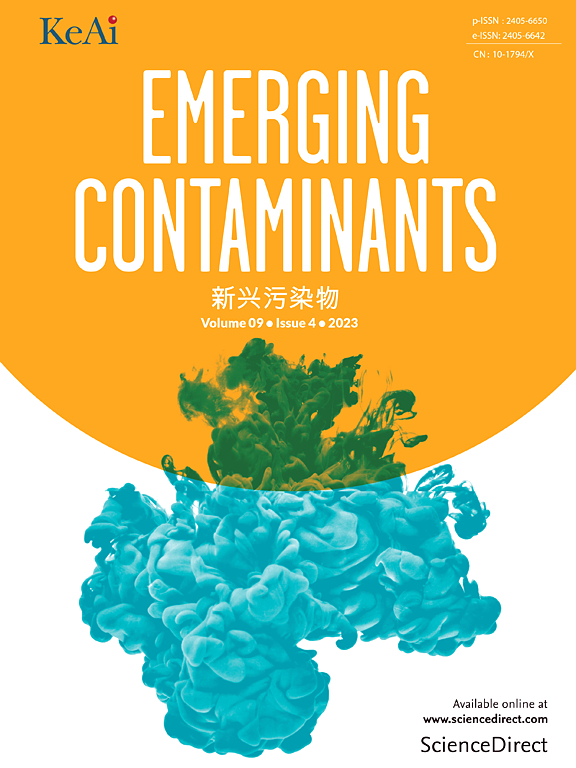大气检测、流行、传播、健康和生态后果抗生素耐药基因和耐药细菌:综合综述
IF 6.9
2区 环境科学与生态学
Q1 ENVIRONMENTAL SCIENCES
引用次数: 0
摘要
抗生素耐药基因(ARGs)和抗生素耐药细菌(ARB)在全球范围内的大气传播对人类健康和环境构成了严重挑战。因此,本文对大气中ARGs和ARB的检测分析方法、分布特征、传播机制、对人类健康和生态环境的潜在影响等方面进行了全面系统的综述。新兴的方法,如人工智能中的机器学习和深度学习,以及等温扩增方法,以及传统的方法,如聚合酶链反应(PCR)、PCR衍生方法和宏基因组测序,大大提高了大气中ARGs和ARB的检测效率。ARGs和ARB广泛存在于各种大气环境中,特别是在医院、制药厂、动物养殖场、污水处理厂、城市固体废物填埋场和人口密集的室内环境中。它们可以通过生物气溶胶在大气中远距离转移,其分布和生存受到气象和气候因素以及空气污染物的显著影响。ARGs和ARB的传播可能改变微生物群落结构,影响生物多样性,并通过吸入、皮肤接触和摄入增加人类接触风险。本文综述了大气中ARGs和ARB的综合情况,为政策制定和进一步研究提供了科学依据,应着眼于开发智能准确的检测方法,构建跨媒介传播机制和全球模型,建立全球健康风险评估体系,以应对抗生素耐药性的全球挑战。本文章由计算机程序翻译,如有差异,请以英文原文为准。

Atmospheric detection, prevalence, transmission, health and ecological consequences of antibiotic resistance genes and resistant bacteria: A comprehensive review
Globally atmospheric transmission of antibiotic-resistance genes (ARGs) and antibiotic-resistant bacteria (ARB) poses a serious challenge to human health and the environment. Thus, a comprehensive and systematic review was established to focus on the detection and analytical methods, distribution characteristics, transmission mechanisms, potential impact on human health and ecological environment of ARGs and ARB in the atmosphere. Emerging methods, such as machine learning and deep learning in artificial intelligence, as well as isothermal amplification methods, have considerably improved the detection efficiency of ARGs and ARB in the atmosphere, along with conventional methods such as Polymerase chain reaction (PCR), PCR derivative methods, and metagenomic sequencing. ARGs and ARB are widely detected in various atmospheric environment, significantly in hospitals, pharmaceutical factories, animal farms, wastewater treatment plants, municipal solid waste landfills and densely populated indoor environments. They can be transferred over extensive distances in the atmosphere via bioaerosols, with their distribution and survival markedly affected by meteorological and climatic factors as well as air contaminants. The transmissions of ARGs and ARB may alter microbial community structures, impact biodiversity, and enhance human exposure risks via inhalation, skin contact, and ingestion. This review synthesizes ARGs and ARB in the atmosphere and provides scientific evidence for policy development and further research, which should focus on the development of intelligent and accurate detection methods, construction of cross-media transmission mechanism and global model, establishment of global health risk assessment system to face the global challenge of antimicrobial resistance.
求助全文
通过发布文献求助,成功后即可免费获取论文全文。
去求助
来源期刊

Emerging Contaminants
Medicine-Public Health, Environmental and Occupational Health
CiteScore
10.00
自引率
6.70%
发文量
35
审稿时长
44 days
期刊介绍:
Emerging Contaminants is an outlet for world-leading research addressing problems associated with environmental contamination caused by emerging contaminants and their solutions. Emerging contaminants are defined as chemicals that are not currently (or have been only recently) regulated and about which there exist concerns regarding their impact on human or ecological health. Examples of emerging contaminants include disinfection by-products, pharmaceutical and personal care products, persistent organic chemicals, and mercury etc. as well as their degradation products. We encourage papers addressing science that facilitates greater understanding of the nature, extent, and impacts of the presence of emerging contaminants in the environment; technology that exploits original principles to reduce and control their environmental presence; as well as the development, implementation and efficacy of national and international policies to protect human health and the environment from emerging contaminants.
 求助内容:
求助内容: 应助结果提醒方式:
应助结果提醒方式:


